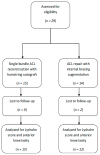The Comparison of Clinical Result between Primary Repair of the Anterior Cruciate Ligament with Additional Internal Bracing and Anatomic Single Bundle Reconstruction-A Retrospective Study
- PMID: 34501400
- PMCID: PMC8432121
- DOI: 10.3390/jcm10173948
The Comparison of Clinical Result between Primary Repair of the Anterior Cruciate Ligament with Additional Internal Bracing and Anatomic Single Bundle Reconstruction-A Retrospective Study
Abstract
Background: The current standard of treatment of anterior cruciate ligament (ACL) is reconstruction (ACLR). This technique has some disadvantages: poor proprioception, donor site morbidity and the inability to restore joint kinematics. ACL repair could be an alternative treatment. The purpose of the study was to compare the stability and the function after ACL primary repair versus single-bundle ACLR.
Methods: In a retrospective study, 12 patients underwent primary ACL repair with internal bracing, 15 patients underwent standard ACLR. Follow-up examinations were evaluated at up to 2 years postoperatively. One patient in the ACL repair group was lost to follow-up due to re-rupture. The absolute value of anterior tibial translation (ATT) and the side-to-side difference in the same patient (ΔATT) were evaluated using the GNRB arthrometer. The Lysholm knee scoring was obtained. Re-ruptures and other complications were recorded.
Results: Anterior tibial translation (ATT) was significantly decreased in the ACL repair group compared with the ACLR group (5.31 mm vs. 7.18 mm, respectively; p = 0.0137). Arthrometric measurements demonstrated a mean side-to-side difference (ΔATT) 1.87 (range 0.2 to 4.9) mm significantly decreased compared to ACLR 3.36 (range 1.2-5.6 mm; p = 0.0107). The mean Lysholm score was 85.3 points in the ACL repair group and 89.9 in ACLR group. No significant differences between ACL repair and ACLR were found for the Lysholm score. There was no association between AP laxity and clinical outcomes. There were two complications in the internal bracing group: one patient had re-rupture and was treated by ACLR, another had limited extension and had arthroscopic debridement.
Conclusions: Anterior tibial translation was significantly decreased after ACL repair. Additionally, the functional results after ACL repair with internal bracing were comparable with those after ACLR. It should be noted that the two complications occurred. The current study supports further development of ACL repair techniques.
Keywords: anterior cruciate ligament (ACL); internal bracing; knee laxity; primary ACL repair.
Conflict of interest statement
The authors declare no conflict of interest.
Figures








Similar articles
-
Repair With Dynamic Intraligamentary Stabilization Versus Primary Reconstruction of Acute Anterior Cruciate Ligament Tears: 2-Year Results From a Prospective Randomized Study.Am J Sports Med. 2020 Apr;48(5):1108-1116. doi: 10.1177/0363546520905863. Epub 2020 Mar 3. Am J Sports Med. 2020. PMID: 32125875 Clinical Trial.
-
Restoring tibiofemoral alignment during ACL reconstruction results in better knee biomechanics.Knee Surg Sports Traumatol Arthrosc. 2018 May;26(5):1367-1374. doi: 10.1007/s00167-017-4742-0. Epub 2017 Oct 24. Knee Surg Sports Traumatol Arthrosc. 2018. PMID: 29067474
-
Bridge-Enhanced Anterior Cruciate Ligament Repair Is Not Inferior to Autograft Anterior Cruciate Ligament Reconstruction at 2 Years: Results of a Prospective Randomized Clinical Trial.Am J Sports Med. 2020 May;48(6):1305-1315. doi: 10.1177/0363546520913532. Epub 2020 Apr 16. Am J Sports Med. 2020. PMID: 32298131 Free PMC article. Clinical Trial.
-
Passive anterior tibia translation in anterior cruciate ligament-injured, anterior cruciate ligament-reconstructed and healthy knees: a systematic review.Musculoskelet Surg. 2019 Aug;103(2):121-130. doi: 10.1007/s12306-018-0572-6. Epub 2018 Oct 16. Musculoskelet Surg. 2019. PMID: 30328030 Free PMC article.
-
Arthroscopic Anterior Cruciate Ligament Repair Versus Autograft Anterior Cruciate Ligament Reconstruction: A Meta-Analysis of Comparative Studies.Front Surg. 2022 Apr 20;9:887522. doi: 10.3389/fsurg.2022.887522. eCollection 2022. Front Surg. 2022. PMID: 35521430 Free PMC article. Review.
Cited by
-
Clinical Results of Primary Repair Versus Reconstruction of the Anterior Cruciate Ligament: A Systematic Review and Meta-analysis of Contemporary Trials.Orthop J Sports Med. 2024 Jun 11;12(6):23259671241253591. doi: 10.1177/23259671241253591. eCollection 2024 Jun. Orthop J Sports Med. 2024. PMID: 38867918 Free PMC article. Review.
-
ACL repair vs. reconstruction: a meta-analysis of outcomes across different tear characteristics.BMC Surg. 2025 Aug 5;25(1):339. doi: 10.1186/s12893-025-03101-6. BMC Surg. 2025. PMID: 40764551 Free PMC article.
-
Comparison of proprioception recovery following anterior cruciate ligament reconstruction using an artificial graft versus an autograft.BMC Musculoskelet Disord. 2022 Dec 3;23(1):1056. doi: 10.1186/s12891-022-06019-9. BMC Musculoskelet Disord. 2022. PMID: 36463165 Free PMC article. Clinical Trial.
-
Augmentation with Fibertape Leads to Biomechanically Superior but Similar Clinical Outcomes in ACL Surgeries: Systematic Review and Meta-analysis.Indian J Orthop. 2023 Jan 6;57(5):722-747. doi: 10.1007/s43465-022-00805-2. eCollection 2023 May. Indian J Orthop. 2023. PMID: 37128558 Free PMC article.
-
A novel home-based rehabilitative knee brace system is a viable option for postoperative rehabilitation after anterior cruciate ligament reconstruction: a report of 15 cases.J Exp Orthop. 2022 Sep 23;9(1):96. doi: 10.1186/s40634-022-00538-z. J Exp Orthop. 2022. PMID: 36149519 Free PMC article.
References
-
- Murray M.M., Kalish L.A., Fleming B.C., Flutie B., Freiberger C., Henderson R.N., Perrone G.S., Thurber L.G., Proffen B.L., Ecklund K., et al. Bridge-Enhanced Anterior Cruciate Ligament Repair: Two-Year Results of a First-in-Human Study. Orthop. J. Sports Med. 2019;7:2325967118824356. doi: 10.1177/2325967118824356. - DOI - PMC - PubMed
-
- Bachmaier S., DiFelice G.S., Sonnery-Cottet B., Douoguih W.A., Smith P.A., Pace L.J., Ritter D., Wijdicks C.A. Treatment of Acute Proximal Anterior Cruciate Ligament Tears-Part 1: Gap Formation and Stabilization Potential of Repair Techniques. Orthop. J. Sports Med. 2020;8:2325967119897421. doi: 10.1177/2325967119897421. - DOI - PMC - PubMed
-
- Jonkergouw A., Van Der List J.P., DiFelice G.S. Arthroscopic primary repair of proximal anterior cruciate ligament tears: Outcomes of the first 56 consecutive patients and the role of additional internal bracing. Knee Surg. Sports Traumatol. Arthrosc. 2019;27:21–28. doi: 10.1007/s00167-018-5338-z. - DOI - PubMed
LinkOut - more resources
Full Text Sources

